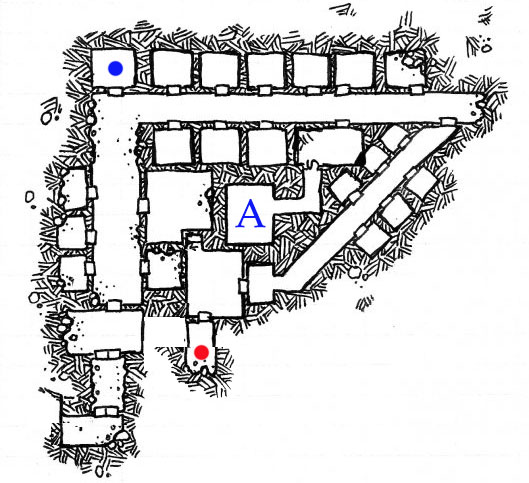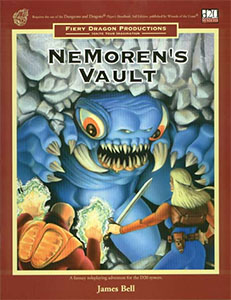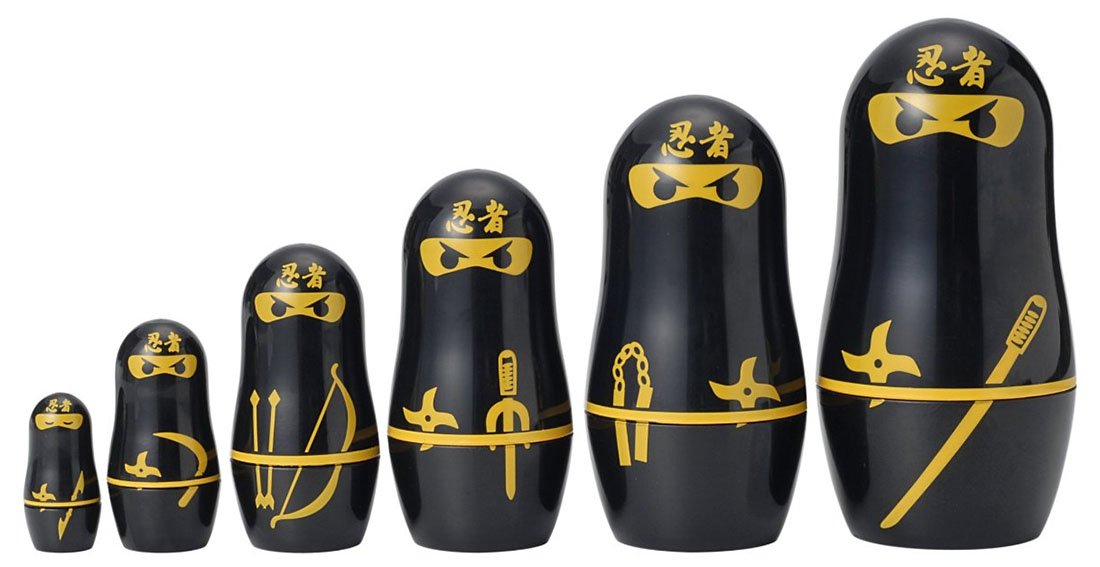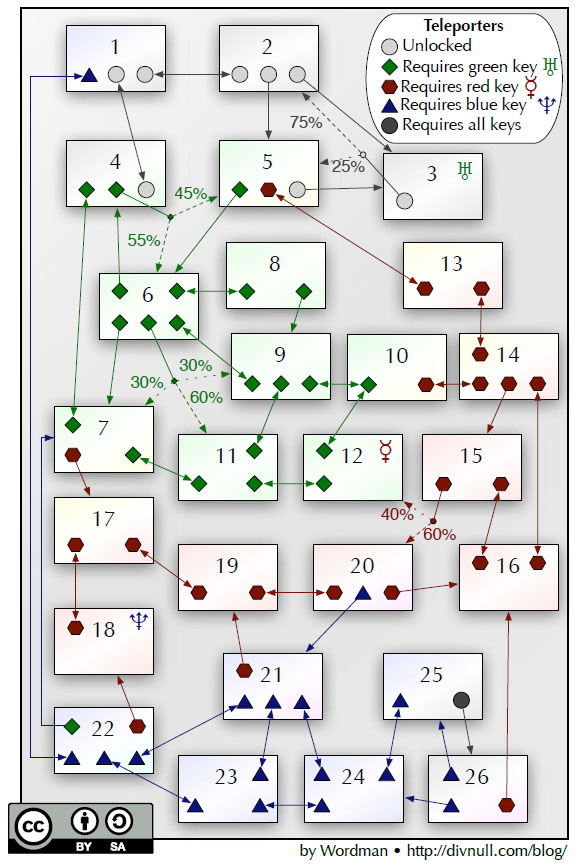LABORATORY #15: CONFUSION FOG
An ovoid room filled with a magical fog which has precipitated into the air. Alchemical equipment is scattered around on a number of tables shaped like crescent moons, but it is badly scarred and pitted from centuries of exposure to the fog.
CONFUSION FOG: Will save (DC 18) or become confused.
LABORATORY #16: MORE SOUL BONDING RESEARCH
A circular chamber. Three tables of sturdy, albeit desiccated, oak are arrayed around the center of the chamber. Along one wall is an empty work bench. On the other stand two upright glass coffins containing demonic humanoids.
TABLES: The tables are designed to shackle people down to them. Iron spikes are attached to the bottom of each table and can be driven down through shackle and arm alike to drain blood into glass containers depending under the tables.
WORK BENCH: In a drawer of the work bench are Bronze Tablet #3 and Bronze Tablet #5.
- Search (DC 16): In a hidden compartment there is a small metal tube. Unscrewing the tube reveals a single sheet of paper with a message written on it. (Handout: Message in the Metal Tube)
ARCHER DEMONS: In the glass coffins and seemingly lifeless. Muscular humanoids with four arms. Each has a large diamond (worth 750 gp) embedded in their forehead.
- Awakening: The glass coffins will open 1d4+2 rouns after anyone enters this chamber who doesn’t bear the Sorcerous Brand of Arn.
- Regeneration: These archer demons have been linked through commingled shield other spells. Each demon suffers the damage taken by the other, but it “bounces” back and forth and is slowly diminished (resulting in their regeneration 5). They can only be permanently destroyed if the diamonds in their heads are removed.
ARCHER DEMON (CR 7+2*) – CE Medium Outsider (Chaotic, Evil, Extraplanar, Tanar’ri)
DETECTION – darkvision 60 ft., Listen +16, Spot +16; Init +4; Languages Old Arathian, Darconic, telepathy 100 ft.
DEFENSES – AC 19 (+4 Dex, +5 natural), touch 14, flat-footed 15; hp 340; DR 5/cold iron; Immune electricity, poison; Resist acid 10, cold 10, fire 10, spell 18
ACTIONS – Spd 40 ft.; Melee 4 claws +15 (1d6+5); Ranged 2 +1 large composite longbow (+5 Str) +12/+12/+12/+7+7 (2d6+6/x3); Base Atk +10; Grapple +15; Atk Options close combat shot; SA spell-like abilities, summon; Combat Feats Point Blank Shot, Precise Shot
SQ darkvision 60 ft., oversized weapons, mirrored archery, telepathy 100 ft.
STR 21, DEX 19, CON 29, INT 14, WIS 16, CHA 12
FORT +16, REF +11, WILL +10
FEATS: Point Blank Shot, Precise Shot, Rapid Shot, Weapon Focus (longbow)
SKILLS: Balance +17, Bluff +14, Climb +18, Concentration +21, Hide +17, Jump +22, Listen +16, Move Silently +17, Sense Motive +16, Spot +16
POSSESSIONS: +1 large composite longbows (Str +5) (x2)Spell-Like Abilities (CL 10)
At will – dimension doorClose Combat (Ex): Does not provoke attacks of opportunity from shooting ranged weapon.
Oversized Weapons (Ex): Can use bows up to one size larger than normal.
Summon (Su): 1/day — 1d6 dretches or 35% chance of summoning an archer demon
Mirrored Archery (Ex): Make additional attack with second bow, -2 penalty on all attacks.
* Potentate (see Legends & Labyrinths).
BRONZE TABLET #3
BONESHATTER
Necromancy
Level: Cleric 5, Sorcerer/Wizard 4
Components: V, S, M
Casting Time: 1 minute
Range: Close (25 ft. + 5 ft./2 levels)
Target: One corporeal creature or object
Duration: Instantaneous and 1 minute/level (see text)
Saving Throw: Fortitude partial (see text)
Spell Resistance: YesThe target’s bones or exoskeleton shiver and splinter, dealing 1d6 points of damage per caster level (maximum 15d6) to the target, who is also exhausted for 1 minute per caster level from the pain and exertion of the transformation.
If the target makes its save, it takes half damage and is fatigued rather than exhausted. Objects made of bone, chitin, or similar material take half again as much (+50%) damage from this spell. This spell has no effect on creatures that lack both skeletons and hard carapaces.
Material Component: A broken bone.
BRONZE TABLET #5
CODESPEAK
Transmutation
Level: Bard 2, Sorcerer/Wizard 2
Casting Time: 1 standard action
Components: V, S, M
Range: Close (25 ft. + 5 ft./2 levels)
Target: You plus one willing creature per two levels, no two of which can be more than 30 ft. apart
Duration: 10 minutes/level (D)
Saving Throw: No
Spell Resistance: NoUpon casting this spell, all recipients gain the ability to speak a new language. This language sounds like random, babbling syllables to anyone not under the influence of the spell, but the targets understand each other perfectly.
Anyone using codespeak can read and write in this new language as well. Once the spell expires, however, any coded writing suddenly appears as gibberish. If the same
individuals become the targets of a codespeak spell again, cast by the same caster, they can once again read any coded writings.
Comprehend languages does not enable a caster to understand the language of another’s codespeak spell, but it does reveal that the targets are speaking a magical language. Tongues translates codespeak normally.
Material Component: A complex rune inscribed on a slip of paper that is then placed under your tongue.
LABORATORY #17: PHANTASMAL HALLS
Swastika-shaped halls filled with phantasmal forces. The walls are undulated in an irregular wave pattern.
PHANTASMAL FORCES: Will save (DC 18) each round or suffer 2d6 damage. The phantasmal forces take various forms manifesting through the primal power channels formed by the swastika.
- Knights charging.
- Howling banshees ripping down the length of the hall.
- Dragons’ heads.
- Hands grasping from the floor.
- Black winds.
- A song ripping at the ears.
TELEPORTALS: Located in each end of the swastika. None-operational red circle (incoming from Laboratory #7), two operational reds, and then a black teleportal.
- Black Teleportal: No key for this teleportal can be found in the current network. (If it could somehow be activated, it would lead to a different network of laboratories not found on the map.)
LABORATORY #18: BESTIARY
All the doors in this area are of glass. Many are broken.
RED DOT: The teleportal.
BLUE DOT: This cell contains two husks and the BLUE KEY. (The key lies in plain sight in the middle of the floor.)
ROOM “A”: Treasure stash. Mostly cleaned out, but there remain 120 pp, 9 violet garnets (500 gp) each, potion of hide from animals, and scroll of dispel magic and flame arrow.
RANDOM ENCOUNTERS: 1 in 6 chance of encountered 1d6 wights.
OTHER CREATURES: Found in various cells. Dead unless otherwise noted.
- Lovecraftian Psionic Flayer
- Giant Ants
- 2 trolls overgrown with 8 assassin vines (the trolls are insane, having been feasted upon by the assassin fines — all are alive)
- 6 wights (“alive”)
- 2 goblins
- Spirit Naga (long, iron prongs extend from its chest; the heart has been unnaturally enlarged and infused with mithril worth 100 gp)
- 4 giant spiders
- 2 troll minions (emaciated from long starvation)
- 5 dragon eggs with 5 baby dragon skeletons (one has its jaws clamped around the throat of another)
LABORATORY #19: TOMB OF UNQUIET WORMS
On a raised, rosette dais stands a rose-colored stone sarcophagus. The tomb effigy depicts a robed man with a flourished moustache clutching a thick tome between his hands.
SPOT (DC 25, or DC 12 with close inspection): The walls are worm-eaten.
UNQUIET WORMS: 1d4 rounds after entering the tomb, a slithering noise can be heard coming from the walls. 1d4 rounds after that, the unquiet worms arrive.
- 12 total. 1d4 arrive per round.
- GM Background: Unquiet worms have feasted upon the brain of a dead mage and become imbued with their arcane powers.
DISPEL MAGIC FIELD: The dais is surrounded by an invisible by a dispel magic field (see Spellbook of Leaves in Laboratory #20).
SARCOPHAGUS:
- Spot (DC 18): To notice that the stone of the sarcophagus is worm-eaten.
- Search (DC 18): Sarcophagus can be pushed back to reveal the teleportal to Laboratory #20.
- Mohrg Lich: The spellcaster within the sarcophagus is a mohrg which can cast the spells it knew in life (see below). It wears pleated sheets of platinum worth 12,000 gp.
UNQUIET WORMS (CR 3+3*): 20 hp (4d8+2), AC 22, bite +6 (1d6+3), Save +6, Ability DC 14
Str 5, Dex 12, Con 11, Int 18, Wis 21, Cha 15
Skills: Alchemy +7, Intimidate +7, Knowledge (arcana) +11, Knowledge (planes) +11, Listen +12, Sense Motive +12, Spellcraft +11, Spot +12, Stealth +8
Scabrous Slime +6 AC (calculated in stat block)
* Class abilities of 8th-level wizard (casting spells per list below).
THE LICH’S SPELLS (4/5/5/5/3, CL 8)
4th (DC 18)—fire shield, ice storm, wall of fire
3rd (DC 17)—blink, dispel magic (x2), fireball, lightning bolt
2nd (DC 16)—darkness, false life, protection from arrows, rope trick, shatter
1st (DC 15)—burning hands, color spray, magic missile, ray of enfeeblement, shocking grasp
0th (DC 14)—dancing lights (x2), mage hand, resistance
Go to Part 6: Laboratories #20-21
Any material in this post not indicated as Product Identity in the Open Gaming License is released by Creative Common Attribution-Share Alike 3.0.
















